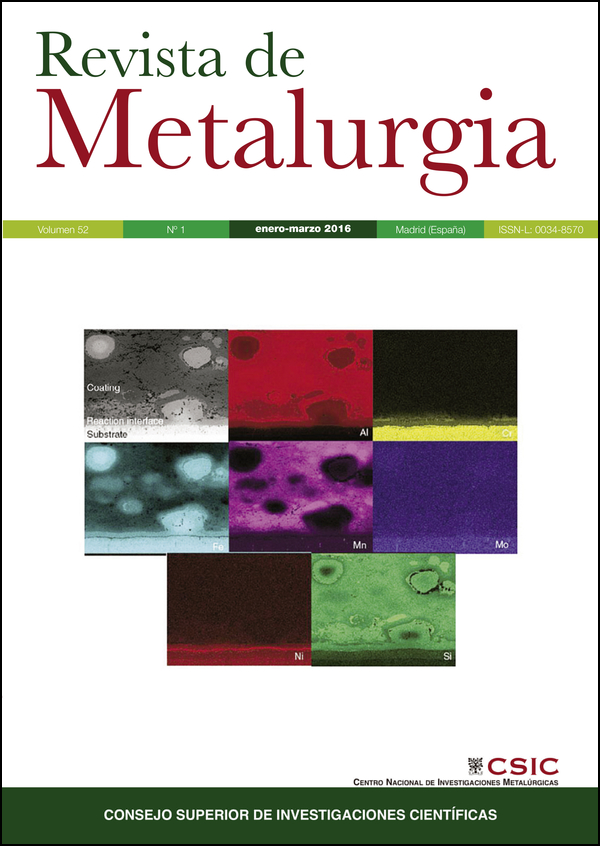Effect of the percentage of reinforcement on the wear in the metal matrix composites sintered with abnormal glow discharge
DOI:
https://doi.org/10.3989/revmetalm.059Keywords:
Coefficient of friction, Compaction pressure, Metal matrix composite, Powder metallurgy, Titanium carbide, Wear coefficientAbstract
In this study an analysis of the behavior of dry wear coefficient of a Metal Matrix Composite (MMC) in 316 stainless steel reinforced with particles of titanium carbide (TiC) according to ASTM G 99 standards, in a pin-on-disk test. In this research it is tested the effect of the percentage of reinforcement in the MMC manufactured with 3, 6 y 9% (vol.) of TiC, in samples compacted at 800 MPa, generating different values of grain size, hardness and density, they are sintered with abnormal glow discharge, at a temperature of 1200 °C ±5 °C, with a protection atmosphere H2 – N2 and a permanence time of 30 minutes. According to the results obtained it is concluded that the best condition for the MMC manufacturing, in relation to the reinforcement percentage, is the one obtained when the mixture contains 6% of TiC compacted at 800 MPa. In these conditions, it was obtained: achieving smaller grain size, the greater hardness and the lowest coefficient of friction. In this respect, it was observed that the incorporation of the ceramic particles (TiC) in a matrix of austenitic steel (316) shows significant improvements in the resistance to the wear.
Downloads
References
Abenojar, J., Velasco, F., Bautista, A., Campos, M. (2003). Atmosphere influence in sintering process of stainless steels matrix composites reinforced with hard particles. Compos. Sci. Technol. 63 (1), 69–79. http://dx.doi.org/10.1016/S0266-3538(02)00179-3
Amig., V., Romero, F., Salvador, M.D., Busquets, D. (2007). Reactividad matriz-refuerzo en compuestos de matriz de titanio pulvimetalurgico. Rev. Metal. 43 (6), 434–447.
ASTM B934 (2010). Standard Test Method for Effective Case Depth of Ferrous Powder Metallurgy (P/M) Parts Using Microindentation Hardness Measurements, ASTM International, West Conshohocken, USA.
ASTM G99-05 (2010). Standard TestMethod for Wear Testing with a Pin on Disk Apparatus, ASTM International, West Conshohocken, PA, California, USA.
ASTM E112 (2013). Standard Test Methods for Determining Average Grain Size, ASTM International, West Conshohocken, PA, USA.
ASTM Vol. 03.02 (2013). Corrosion of Metals; Wear and Erosion, West Conshohocken, PA, USA.
Benavente, R. (2015). Desarrollo de materiales cerámicos avanzados con altas prestaciones mediante técnicas no convencionales de sinterización: microondas. Tesis Doctoral, Universidad Politécnica de Valencia (UPV), p. 243.
Ceschini, L., Palombarini, G., Sambogna, G., Firrao, D., Scavino, G., Ubertalli, G. (2006). Friction and wear behaviour of sintered steels submitted to sliding and abrasion tests. Tribol. Int. 39 (8), 748–755. http://dx.doi.org/10.1016/j.triboint.2005.07.003
Dogan, O, Hawk, J., Tylczak, J., Wilson, R., Govier, R. (1999). Wear of titanium carbide reinforced metal matrix composites. Wear 225–229, 758–769. http://dx.doi.org/10.1016/S0043-1648(99)00030-7
Feng, S.-R., Tang, H.-B., Zhang, S.-Q., Wang, H.-M. (2012). Microstructure and wear resistance of laser clad TiB–TiC/TiNi–Ti2Ni intermetallic coating on titanium alloy. T. Nonferr. Metal. Soc. 22 (7), 1667–1673. http://dx.doi.org/10.1016/S1003-6326(11)61371-X
Gómez, F., Caballero, J.M., Herrera, E.J. (1998). Algunas observaciones sobre la sinterización del acero austen.tico 316L en atmósfera de argón. Rev. Metal. 34 (NÅã Extra), 267–270.
Guerrero, U., Parra, C., Sarmiento, A. (2011). Procesamiento en descarga luminiscente de la perovskita YBa2Cu3O7-d. DYNA 78 (169), 201–205.
Iglesias, F., Mart.nez, C., Cotes, M.T., Ruiz, J.M., Garc.a, L.E., Corpas, F.A. (2014). Influencia de la atmósfera de sinterización en las propiedades mecánicas de los aceros P/M AISI 430L. Rev. Metal. 50 (1), e008.
Ni, Z., Sun, Y., Xue, F., Bai, J., Lu, Y. (2011). Microstructure and properties of austenitic stainless steel reinforced with in situ TiC particulate. Mater. Design. 32 (3), 1462–1467. http://dx.doi.org/10.1016/j.matdes.2010.08.047
Onuoha, C., Kipouros, G., Farhat, Z., Plucknett, K. (2013). The reciprocating wear behaviour of TiC–304L stainless steel composites prepared by melt infiltration. Wear 303 (1–2), 321–333. http://dx.doi.org/10.1016/j.wear.2013.03.040
Renedo, J. (2010). Comportamiento al desgaste por deslizamiento en aceros inoxidables: ferrítico, austenítico, dúplex y martensítico. Proyecto final de carrera, Universidad Politécnica de Catalunya (UPC).
Sheikhzadeh, M., Sanjabi, S. (2012). Structural characterization of stainless steel/TiC nanocomposites produced by highenergy ball-milling method at different milling times. Mater. Design. 39, 366–372. http://dx.doi.org/10.1016/j.matdes.2012.02.011
Srivastava, A.K., Das, K. (2010). The abrasive wear resistance of TiC and (Ti,W) C-reinforced Fe–17Mn austenitic steel matrix composites. Tribol. Int. 43 (5–6), 944–950. http://dx.doi.org/10.1016/j.triboint.2009.12.057
Sun, G.J., Wu, S.J., Su, G.C. (2010). Research on impact wear resistance of in situ reaction TiCp/Fe composite. Wear 269 (3–4), 285–290. http://dx.doi.org/10.1016/j.wear.2010.04.011
Torralba, J.M., Campos, M. (2014). Toward High Performance in Powder Metallurgy. Rev. Metal. 50 (2), e017. http://dx.doi.org/10.3989/revmetalm.017
Velasco, F., Lima, W.M., Ant.n, N., Aben.jar, J., Torralba, J.M. (2003). Effect of intermetallic particles on wear behaviour of stainless steel matrix composites. Tribol. Int. 36, (7), 547–551. http://dx.doi.org/10.1016/S0301-679X(02)00264-5
Xinhong, W., Zengda, Z., Sili, S., Shiyao, Q. (2006). Microstructure and wear properties of in situ TiC/FeCrBSi composite coating prepared by gas tungsten arc welding. Wear 260 (7–8), 705–710. http://dx.doi.org/10.1016/j.wear.2005.03.018
Zhong, L., Xu, Y., Hojamberdiev, M., Wang, J., Wang, J. (2011). In situ fabrication of titanium carbide particulates-reinforced iron matrix composites. Mater. Design. 32 (7), 3790–3795. http://dx.doi.org/10.1016/j.matdes.2011.03.031
Published
How to Cite
Issue
Section
License
Copyright (c) 2016 Consejo Superior de Investigaciones Científicas (CSIC)

This work is licensed under a Creative Commons Attribution 4.0 International License.
© CSIC. Manuscripts published in both the printed and online versions of this Journal are the property of Consejo Superior de Investigaciones Científicas, and quoting this source is a requirement for any partial or full reproduction.
All contents of this electronic edition, except where otherwise noted, are distributed under a “Creative Commons Attribution 4.0 International” (CC BY 4.0) License. You may read the basic information and the legal text of the license. The indication of the CC BY 4.0 License must be expressly stated in this way when necessary.
Self-archiving in repositories, personal webpages or similar, of any version other than the published by the Editor, is not allowed.
















